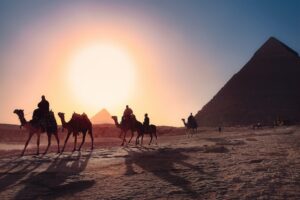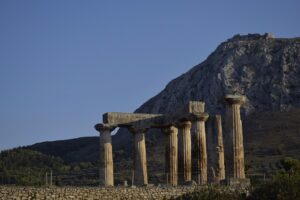Each antique civilization had its individual theory or faith on how the whole kit and caboodle came into being. The early Egyptians had a bright mind’s eye that led to a sum of multifaceted descriptions of how the ancient Egyptians were made.
They supposed at the instant of creation, world order was generated, which confined the basic principles of life, Mother Nature, and civilization that were ruled by the deities at the instant of creation.
All the pyramid’s transcripts from the ancient kingdom (2780-2250 BC) situated on the pyramid walls, catacombs, shrines, and the mythological book of the dead have all the material connected to the creation myth. Let’s have a little look:

The Water Gods Of Egypt
As the myth goes, there was only water in the start. There were eight deities resting in the primeval waters named the Ogdoad, and they were in pairs. They could be a couple or just a masculine and feminine. These eight gods are frequently presented as having the skulls of frogs since they are water gods. Nevertheless, there isn’t more acknowledged about them but their characteristics.
Also Read: Osiris In Myth And History
Primarily, there were Hok and Hoket. And their attribute was amorphousness. To recall who is masculine and who is the feminine of the pair, the female term continuously finishes with “t.” Accordingly, Hok is the masculine, and Hoket is the feminine. A remarkable note about Egyptian linguistics is that the female form of Egyptian words culminates in “t.”
Subsequently, come Kuk and Kuket: their attribute is darkness. The Amun and Amunet, the representative of invisibility, are following. Amun developed into possibly the most significant God in prehistoric Egypt. This was countless years later, with the arrival of the pharaoh Amunhotep, whose name says, “Amun is satisfied.”
The final pair is Nun and Nunet. Nun is the primeval waters with Nunet as his associate.

What Are The Egyptians Straining To Clarify With These Eight Gods?
Dwell on the characteristics: amorphousness, darkness, invisibility. These are not optimistic qualities. They’re undesirable, demonstrating disorder at the start of the universe. Then the instant of creation happens.
Deities Of Air, Moisture, Earth, And Sky
Out of the waters rises the primeval hill, and upended on that primeval hill was the deity Atum. Atum is an exceptional god. He generates the gods that interrelate with the earth. He is named the self-made. Atum has two children named Shu and Tefnut. Shu is air, and Tefnut is moist. The legend tells us that there was air and wetness at the start.
Ponder the initial line of Genesis: “In the start, God shaped the heavens and the earth. Now the earth was a shapeless void. There was darkness over the abysmal.” See the resemblance that in the start, there is a shapeless void. Naturally, the Egyptian myth is way older than the Old Testament. Nonetheless, the point is that individuals seem to reach an agreement that the start was tempestuous.
Also Read: Isis And The Seven Scorpions
Shu and Tefnut have two children as well. They are named Geb and Nut. Geb depicts the earth, and Nut is the skies. There’s a portrait of Nut on the ceiling of a regal tomb, meandering over with her arms down a single wall and her legs down one more, with her abdomen as the roof. Nut gulps the sun in the twilight; it voyages through her, and she births it in the dawn. It is basically representing birth and the renaissance.

The Famous Four
Geb and Nut birthed Isis, Osiris, Seth, and Nebthet who are dominant in Egyptian mythology. Primarily are Isis and Osiris, who are brother and sister. And in the later years, they are correspondingly husband and wife. See that the term Isis, the womanly God, doesn’t finish in a “t.” This is because her name originated from the Greeks. Her actual name in Egyptian is Ist. However, the Greeks added their tongue’s “is” finishes, so It turned out to be Isis.
Seth and Nebthet are similarly brother and sister. And they also turn out to be husband and wife. The four of them—Isis, Osiris, Seth, and Nebthet—are central to the complete following story of antique Egyptian mythology.

The Appearance(s) Of The Gods
Contemporary academics interpret the Egyptian word “god” as netjer, inscribed in hieroglyphs as an enfolded pole with a flag on maximum. It is a symbol of heavenly presence that goes back to the Predynastic eras.
Nevertheless, it is well-defined that this term included not only what we would cogitate as gods but similarly idolized humans, additional kinds of mystic beings, and even frenzied monsters. These include the huge serpent Apophis, the principal adversary of the sun god Ra. Souls of the dead (akhu), demonic inhabitants of the underworld, and creatures named bau, which was appearances of the gods that functioned as their envoys, were also dreaded and esteemed.
Also Read: How to start a profitable Affiliate marketing business
The deities took numerous physical shapes: anthropomorphic (humanoid), zoomorphic (animal), hybrid (with the skull of either a humanoid or animal and the figure of the conflicting type), and composite (where features of dissimilar gods were combined into one shape).
A lot of deities were graceful in the way they were symbolized, and a truthfully permanent form for any god was fairly unusual. From time to time, only the name obviously stipulates which deity is being characterized. The God Thoth, for instance, was habitually portrayed in a human form and the skull of an ibis. But it could likewise be characterized as an ibis or a monkey in completely animal form.

Demise, Cycles, And The End Of Time
Egyptian deities were not stationary beings. Osiris, one of their most vital gods, really died (though the texts do not ever straightforwardly say this. they do mention him being dissected, mummified, and entombed) and then converted into the God of the Underworld. Additional gods like the sun god Ra had successions.
Ra was supposed to reach his peak at noon (as Harakhti), grow old at the culmination of the day (as Atum), “expire” at night, unifying with Osiris in the pits of the netherworld to endorse renewal. And then was resuscitated again with the dawning (as Khepri). In the Egyptian interpretation, life brought about death and then death returned as fresh life.
The cycle pertained to humans and the gods similarly, allowing them to develop young again with everlasting monotony.
At the end of time, the Egyptians supposed that all the diversity of the universe, counting the gods, would return to the indistinguishable disorder of time before formation. And the whole thing amalgamates back into primitive waters.







